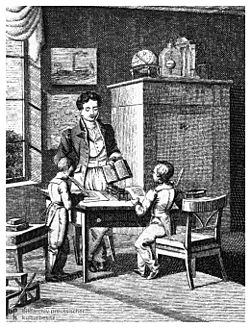Bourgeois revolution facts for kids
Bourgeois revolution is a term used in Marxist theory to refer to a social revolution that aims to destroy a feudal system or its vestiges, establish the rule of the bourgeoisie, and create a bourgeois (capitalist) state. In colonised or subjugated countries, bourgeois revolutions often take the form of a war of national independence. The Dutch, English, American, and French revolutions are considered the archetypal bourgeois revolutions, in that they attempted to clear away the remnants of the medieval feudal system, so as to pave the way for the rise of capitalism. The term is usually used in contrast to "proletarian revolution", and is also sometimes called a "bourgeois-democratic revolution".
Contents
Theories of bourgeois revolution
According to one version of the two-stage theory, bourgeois revolution was asserted to be a necessary step in the move toward socialism, as codified by Georgi Plekhanov. In this view, countries that had preserved their feudal structure, like Russia, would have to establish capitalism via a bourgeois revolution before being able to wage a proletarian revolution. At the time of the Russian Revolution, the Mensheviks asserted this theory, arguing that a revolution led by bourgeoisie was necessary to modernise society, establish basic freedoms, and overcome feudalism, which would establish the conditions necessary for socialism. This view is prominent in Marxist-Leninist analysis.
Political sociologist Barrington Moore Jr. identified bourgeois revolution as one of three routes from pre-industrial society to the modern world, in which a capitalist mode of production is combined with liberal democracy. Moore identified the English, French, and American revolutions as examples of this route.
Neil Davidson believes that the establishment of democracy or the end of feudal relations are neither defining characteristics of bourgeois revolutions, but instead supports Alex Callinicos' definition of bourgeois revolution as being those that establish "an independent center of capital accumulation".
Other theories describe the evolution of the bourgeoisie as not needing a revolution. The German bourgeoisie during the 1848 revolution did not strive to take command of the political effort and instead sided with the crown. Davidson attributes their behaviour to the late development of capitalist relations and uses this as the model for the evolution of the bourgeoisie.
The goals of the bourgeois revolution
According to the Marxist view, the tasks of the bourgeois revolution include:
- The creation of the nation state (which can be constituted differently in different peoples).
- The constitution of the state on the basis of popular sovereignty (the rule of law is based on a constitution adopted by the people).
- Bourgeois rule if possible in the form of a democratic republic (which, however, already found its complement in tyranny in antiquity).
- The abolition of serfdom, and the formation of free wage workers instead.
- The separation of producers from the means of production in primitive accumulation.
- The abolition of the guilds and freedom of investment.
- The free development of the productive forces until they are ripe for social revolution.
Bourgeois revolutions in history
Bourgeois revolutions in the middle ages
Although with much less diffusion, some social movements of the European Late Middle Ages have also received the name of bourgeois revolution, in which the bourgeoisie begins to define itself in the nascent cities as a social class. Examples include the Ciompi Revolt in the Republic of Florence, Jacquerie revolts during the Hundred Years' War in France, and Bourgeois revolts of Sahagún in Spain.
Bourgeois revolutions in the early modern period
The first wave of bourgeois revolutions are those that occurred within the early modern period and were typically marked by being driven from below by the petty bourgeoisie against absolutist governments.
 German Peasants' War (1524–1525) (it has been labelled by later historians as an early attempt at a bourgeois revolution)
German Peasants' War (1524–1525) (it has been labelled by later historians as an early attempt at a bourgeois revolution) Eighty Years' War, also known as the Dutch revolution, (1566–1648)
Eighty Years' War, also known as the Dutch revolution, (1566–1648) English Revolution (1640–1660)
English Revolution (1640–1660) American Revolution (1765–1791)
American Revolution (1765–1791) French Revolution (1789–1799)
French Revolution (1789–1799)
Bourgeois revolutions in the late modern period
The second wave of bourgeois revolutions are those that occurred within the late modern period and were typically marked by being led from above by the haute bourgeoisie.
 July Revolution (1830)
July Revolution (1830) February Revolution (1848)
February Revolution (1848) German revolutions of 1848–1849
German revolutions of 1848–1849Revolutions of 1848 in the Italian states
 Hungarian Revolution of 1848
Hungarian Revolution of 1848 Philippine Revolution (1896–1898)
Philippine Revolution (1896–1898) 1905 Russian Revolution (1905–1907)
1905 Russian Revolution (1905–1907) Persian Constitutional Revolution (1905–1911)
Persian Constitutional Revolution (1905–1911) Young Turk Revolution (1908)
Young Turk Revolution (1908) Chinese revolution of 1911 (1911–1912)
Chinese revolution of 1911 (1911–1912) Mexican Revolution (1910–1917)
Mexican Revolution (1910–1917) February Revolution (called "bourgeois-democratic revolution" in Soviet historiography)
February Revolution (called "bourgeois-democratic revolution" in Soviet historiography)
See also
 In Spanish: Revoluciones burguesas para niños
In Spanish: Revoluciones burguesas para niños


